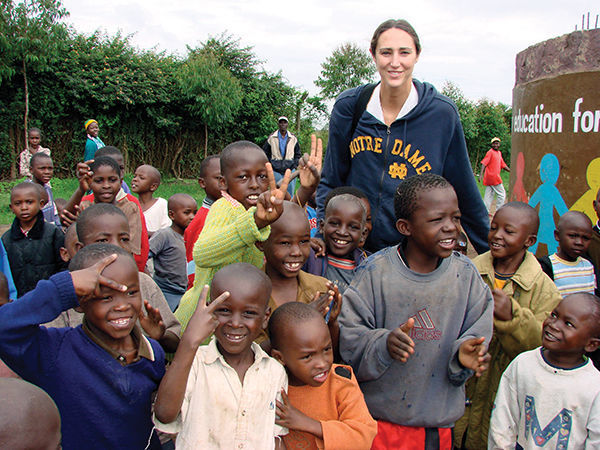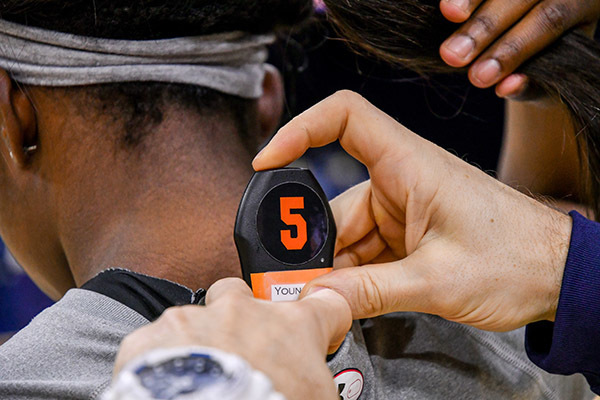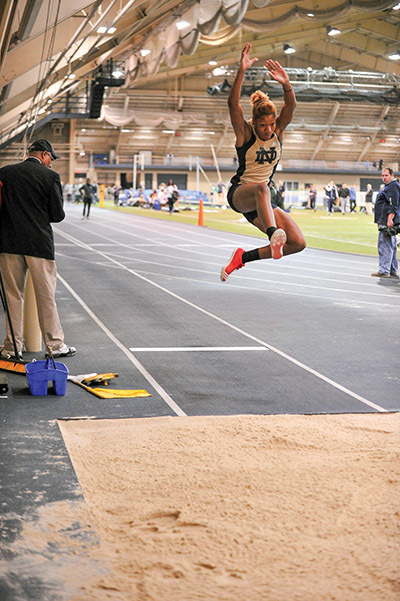Claire Gallerano VeNard ’07 knows from experience that the term student-athlete needs more than a hyphen to hang together in a meaningful way. VeNard played soccer at Notre Dame, a claim on her time and energy that restricted other opportunities — internships, study abroad — that have become commonplace college rites of passage.
Students fan out, overseas for a semester or a year, to professional apprenticeships for the summer, acquiring life experience, assembling resumes, accumulating contacts. Athletes train.
Even the routine rhythms of the academic calendar move at a quickened pace for the 740 athletes who are also Notre Dame students. A recent women’s rowing workout included intense training on indoor machines that left one team member doubled over from exhaustion. The session lasted from 3:30 to 5:30 p.m. The wiped-out rower had a chemistry test at 6.
“That’s their reality,” says VeNard, who lived it herself as an American Studies major and aspiring law student while playing midfield for national-championship contending teams.
The unrelenting responsibilities of school and soccer left little room for extracurricular exploration. One day on the way to class, VeNard spotted a flyer promoting a six-week summer internship in Ireland.
It was perfect: a chance to go abroad, a job with the Olympic Council of Ireland and brief enough in duration to be feasible in the weeks before her senior season. At that time, though, there was no formal, institutional support for an athlete to take such a trip.
VeNard had to work out the details herself with head coach Randy Waldrum. He was anxious but amenable with assurances that she would maintain her training beyond lifting pints of Guinness.
She came back in shape and contributed to the 2006 women’s soccer team that reached the national title game. But the Ireland internship had created another complication. VeNard wanted to go to law school but missed her chance that summer to take the LSAT entrance exam. The only other realistic opportunity would overlap with her sport’s Final Four.
There would be an LSAT administered that weekend at Duke University, not far from the Cary, North Carolina, site of the games. The scheduling coincidence added motivation — one way or another, VeNard would be in North Carolina that December weekend, so she was determined that her team be there, too — but also pressure. To prepare for life after college and to perform on the field at the same time, the twin expectations of student-athletes that often lead to conflicting priorities.
Studying for the LSAT amid school and soccer obligations meant lugging along a prep book on road trips and turning every flight and layover into a mobile library. The situation built to an almost absurd conclusion.
With the national title on the line, the end of her soccer career at hand and her future at stake, here were four days in the life of Claire VeNard, student-athlete:
Thursday — Deliver a speech on behalf of her team at the College Cup banquet
Friday — Play in the national semifinal
Saturday — Take the LSAT
Sunday — Play in the national championship game
“In no world was that a good plan,” she says with a laugh, but it had a happy ending with her acceptance into the Washington University in St. Louis law school.
As extreme as the circumstances were in VeNard’s case, the distinct parts of her experience combined to fulfill the promise Notre Dame makes to recruits to promote, in equal measure, their athletic, academic and personal growth. With a do-over, she just might have rearranged how the parts fit together.
“If I could go back in time,” she says, “I would have done things a lot differently.”
Part of her job now is to make it possible for today’s Notre Dame athletes to have the well-rounded experience she did with fewer sharp edges. VeNard is the program director in the athletic department’s Student Welfare and Development office, the place where Notre Dame tries to live up to the hyphen.
Mike Harrity is the senior associate athletic director in charge. He came to Notre Dame in 2011 to implement athletic director Jack Swarbrick’s vision for a comprehensive strategy to enhance the overall college experience for athletes. The operation now encompasses everything from leadership training and career advising to a study abroad program, sports psychology and high-tech performance science.
Implicit in the existence of Student Welfare and Development is an acknowledgment that, no matter how committed Notre Dame might be to the notion, college athletes these days realistically cannot live an “ordinary” student life. Not without conscious effort to carve dedicated time and mental space out of the precious few weeks, days and hours that their sports responsibilities permit.
Notre Dame asks a lot of its athletes. Through Student Welfare and Development, the athletic department effectively asks itself how Notre Dame can make good on its end of the deal and put the recruiting pitch of a multifaceted student experience into practice — without, of course, sacrificing competitive success.
“Delivering on that promise becomes a really fun puzzle to put together,” Harrity says, “and if you’re not intentional about identifying the pieces and getting people who can put that together, it’s just not going to go where we need it to go.”
One place it has gone is to South Africa. Interest from athletes for study abroad opportunities — their sports obligations made traditional offerings impractical — led to a partnership with Notre Dame International and a plan tailored to their needs.
Two years ago, a group of 16 athletes representing seven sports spent three weeks in South Africa through a program designed by psychology professor Anré Venter and Notre Dame International’s Rosemary Max. Former women’s basketball player Ruth Riley ’01, ’16MBA was back on campus in graduate school at the time and also played an important role in making it happen.

Riley had experience with humanitarian work abroad after her undergraduate days. She knew the impact such opportunities could have, but she also understood the restrictions on athletes while still in school and could speak with authority about bridging those responsibilities. The organizers, including welfare and development representatives, met with coaches and trainers to address concerns about the trip distracting from the meticulous rigor of offseason workouts.
“We sort of institutionalized a lot of things that I was having to do on my own when I was by myself in Ireland,” VeNard says. A strength coach even went along the first year to keep everybody honest.
Since then, it has grown from the single South African trip to more than a half-dozen destinations open to all students, not just athletes, who want an international experience with less of a time commitment. The program’s growth stands as a model for what welfare and development wants to do.
At its best, Harrity says, it offers cross-campus partnerships that open doors previously closed to athletes and also fulfill a need among the general student body.
Win-win, as they say, although the welfare and development objectives do not end there. Scoreboard-variety victory remains the ultimate goal.
The competitive intensity necessary to thrive in high-level sports, in and of itself, can be all-consuming. The expectations, like the size and speed of the athletes carrying them, are only increasing. Their talent and internal motivation, combined with the academic challenge they accept when signing up, suggests they have the will to succeed in a high-pressure environment.
Still. The characteristics that got them this far are tested under conditions that could not be much less suited to producing optimal sports performance. Testing themselves in that environment is a big part of the appeal for many Notre Dame recruits. Duncan French was one of them.

Last year, French became Notre Dame’s first director of performance sciences, the hub of technology, training, nutrition, injury recovery and prevention. He established protocols across programs to support coaches, trainers and athletes with customized, cutting-edge approaches specific to their sport and individual needs.
There’s an overarching focus on “health and well-being,” the management of stress and fatigue that athletes encounter as a matter of course. Better nutrition, more sleep, optimum music selection for workouts, attention to circadian rhythms across different time zones.
Beyond that, things get biomechanical, allowing French to apply his exercise physiology Ph.D. in fine-tuned training routines. What he calls “a glorified weighing scale” measures force-velocity, or the pressure and acceleration an athlete generates. “That’s got implications for change of direction, for taking off the diving board, for starts in the pool, for sprinting on the field,” French says, “and we can monitor that over time.”
GPS technology tracks running speeds and distance covered, heart-rate monitors gauge exertion, each contributing to an immediate and empirical measure of effort and fatigue. At training camp last August, football coach Brian Kelly could review real-time data to determine whether a player should be pushed harder or needed to rest. The hockey team posts players’ heart rates on the screen above the ice during practice, a green-yellow-red scale, intensity levels in living color. Daily reports for coaches detail the information so they can adjust individual or team workouts to sharpen physical preparation for a game.
Performance science also incorporates 3-D motion capturing, like movies or video games, to establish a “movement blueprint” for every athlete. The objective is to find inefficiencies, weak spots that could improve with tailored training, or physical risks that could be corrected.
“If someone’s got a tight left hip, then that’s a red flag for injury if you’re a soccer player, and we need to address that,” French says. “Without that clarity, then that might just go unidentified, and therefore it’ll break down.”
Perhaps the most significant injury concern in sports today is the connection between repeated blows to the head — most notably in football — and traumatic brain damage. Notre Dame has had tragic connections to the degenerative brain disease chronic traumatic encephalopathy (CTE), linked to the deaths of former football players Dave Duerson ’83 and Pete Duranko ’66. Through posthumous brain examinations performed at Boston University, both were found to have suffered from CTE.
Duranko’s classmates established a fund in his honor to raise money for anticoncussion programs in the Notre Dame athletic department. The Pete Duranko Fund for Student-Athlete Safety raised nearly $200,000 for its 50-year class gift and continues to receive donations earmarked to advance the prevention and treatment of sports-related brain injuries.
“That’s been a godsend to us,” French says. “It’s allowed our medical staff to purchase and acquire certain cutting-edge technologies, from eye-scanning technology to balance assessment technology. We’re going to be looking at some brainwave technology following brain impacts — how the brainwaves change and if we can help address that.”
The list of issues to address and the methods available seem endless and endlessly evolving. So does the roster of people involved. French himself moves on this month to become a vice president with the Ultimate Fighting Championship, but Harrity says the athletic department will continue building on the foundation he established.
If performance sciences is the high-tech hub, the spokes are the 26 athletic programs, each with its own set of human and technical specifications. A high-jumper and a hockey player, a pitcher and a volleyball libero, a power forward and swimmer all have particular training needs.
Within a single sport, academic demands often call for bespoke scheduling. Two fencers, say, one in engineering, the other an English major, might have to be accommodated in different ways at different times in the semester.
Those factors don’t even account for the complications of personal lives or the diverting vagaries of travel, all of which contribute to the fluid dynamics that influence what happens on the field. How do they begin to get their arms around such an amorphous set of circumstances? They take what Harrity calls a “performance-team approach.”
A group of people specific to each team, including the coaching staff, trainers, nutritionists, academic advisers and the administrator assigned to the program meet regularly. They go through the roster and identify any areas of concern. An assistant coach who recruited an athlete in high school might have a relationship with the family and be able to help with a problem at home. A recurring injury could require a lighter workload or an adjustment in technique. Maybe the academic adviser reports on a player’s exam grade and encourages positive reinforcement from the coaches.
Even how to deliver such feedback in a way that will have the most impact on each individual is an empirical matter. Harrity’s group administers personality tests to coaches and players alike, intended to teach them about themselves and their teammates, to foster understanding that strengthens their relationships and, ultimately, improves their performance.
Men’s tennis coach Ryan Sachire ’00, a three-time All-American singles player, appreciates how the information deepens his personal connection to his players. Not everything can be individualized, he notes, but his staff treats each athlete with attention to the style shown to be most conducive to their development.
“How we coach in matches, practice, how we try to motivate them — all different, all depending on what makes them tick and what’s going to be most effective for them,” Sachire says.
To Jes Christian ’14, a former high jumper and sprinter, and president of the student-athlete advisory council, the expressed commitment to personal and athletic progress tracks with her Notre Dame experience. Now assistant director of special events in the Duke athletic department, she reveled in the leadership opportunity the advisory council offered. Her legacy includes revamping and rebranding an ongoing initiative called IrishOn3, a competition that encourages athletes to support sports other than their own.
While at Notre Dame, Christian also changed majors, suffered injuries, wrestled with her sense of self as she discarded the defining label of “athlete.” Through it all she found understanding and forward-looking encouragement from athletic administrators whose concern could have begun and ended with her personal bests.

“I think that Notre Dame really kicks it into full gear when trying to make sure that student-athletes are supported in that way,” Christian says. An emphasis on “life post-graduation,” she adds, helps athletes see the bigger picture that their sports experience is meant to bring into focus.
In the competitive hothouse of college sports, the difference between winning and losing is narrowing. The performance science infrastructure aims to keep Notre Dame at the cutting edge of that fine line. Welfare and development gets to know the people beyond the numbers and names on the jerseys, to help them develop a game plan to reach more distant goal lines.
“To deliver on that,” Harrity says, “is the ultimate challenge.”
Jason Kelly is an associate editor of this magazine.